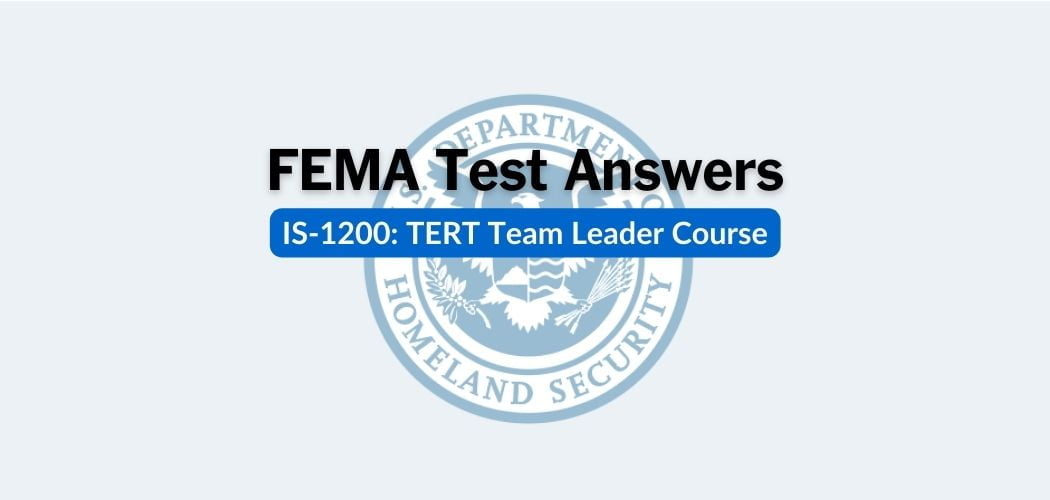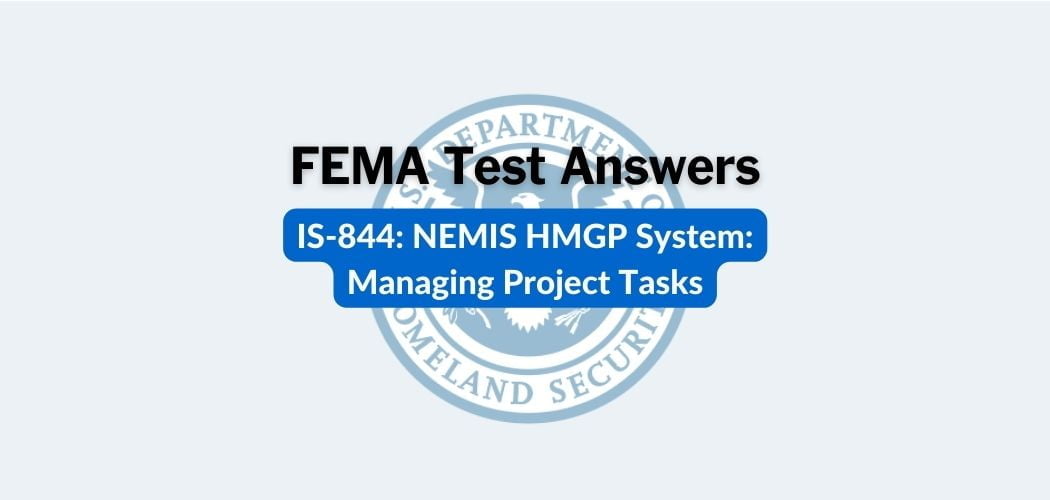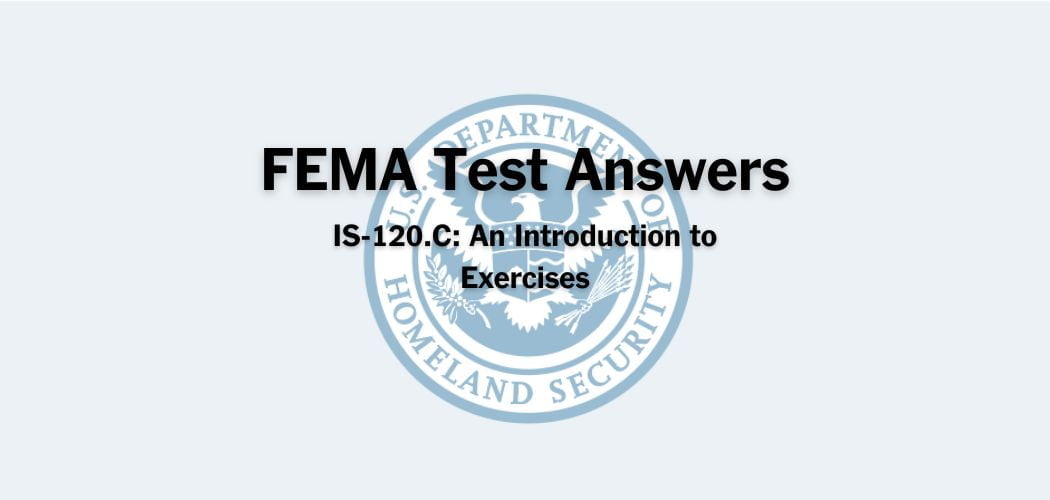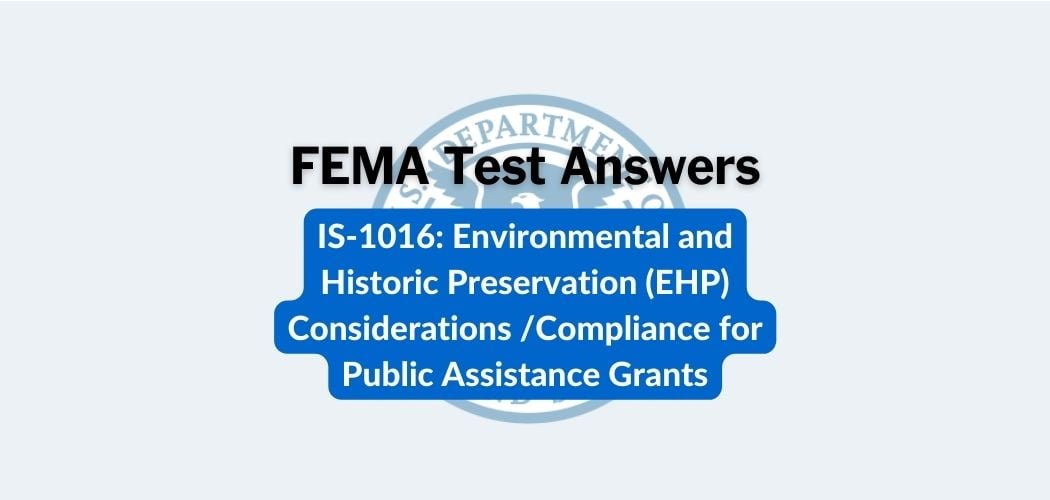Overview: The FEMA IS-554 course was published on 10/31/2013 to explain how public works prepare and plan for emergencies. By the end of this course, participants will be able to:
- Explain the relationships between public works activities and emergency planning
- Describe how to establish a planning team
- Explain how risk and vulnerability assessments are used in public works planning
- Explain how to plan for each activity in the emergency management process
- Explain basic principles for implementing and maintaining a public works emergency plan.
Primary audience: FEMA IS-554 is for public works professionals, urban planners, local government officials, and elected officials. It is strongly suggested to take IS-552.
FEMA IS-554 test answers
Each time this test is loaded, you will receive a unique set of questions and answers. The test questions are scrambled to protect the integrity of the exam.
Question 1. Which of the following is NOT generally an important consideration when gathering information to include in the public works agency-specific plan?
A. Conducting and maintaining an inventory of goods and supplies
B. Including risk and vulnerability assessment information for the community
C. Researching the total number of local government employees✅
D. Correlating the public works plan with the community-wide emergency plan
Question 2. Which of the following is an important aspect of conducting an after-action review?
A. The review is conducted privately with each member of the team to avoid placing blame.
B. The after-action review will be used to develop an improvement plan.✅
C. The review focuses only on what went right during the event.
D. An after-action review is primarily an accountability tool that is shared with the public.
Question 3. Which of the following statements most accurately describes recovery activities included in the emergency plan?
A. Recovery activities might include efforts to restore utilities, clear debris, and restore services to critical customers such as nursing homes and hospitals.✅
B. Recovery activities performed by public works are divided into four basic categories.
C. Recovery activities will include damage assessment, identification of infrastructure disruption, securing facilities, and clearing streets.
D. Recovery activities are the sole responsibility of the public works agencies.
Question 4. What two steps in the hazard analysis process should take place before conducting an inventory of assets?
A. Profiling hazards, predicting risks
B. Predicting risks, estimating losses
C. Estimating losses, identifying hazards
D. Identifying hazards, profiling hazards✅
Question 5. Which of the following best describes the importance of emergency planning to public works activities?
A. The emergency planning process begins with the evaluation of risks and vulnerabilities, especially to critical infrastructure.
B. The public works agency should be involved in all preparedness activities to ensure a cohesive response effort and quicker recovery.✅
C. Maintaining emergency facilities is the only area of emergency planning that involves public works.
D. Public works activities have less of an impact on reducing the loss of life and property than activities performed by other government agencies.
Question 6. Which response activity listed below would NOT generally need to be included in a public works emergency plan?
A. Building inspection services
B. Debris removal✅
C. Damage assessment
D. Medical transport
Question 7. Which of the initial tasks for the planning team would include setting the frequency of meetings so that everyone participating can have a voice in creating a schedule?
A. Assigning administrative planning assignments
B. Defining agency jurisdiction
C. Identifying the mission
D. Establishing expectations✅
Question 8. Restoration and reconstruction of critical infrastructure and key resources would most likely be included under which component of an emergency plan?
A. Communication capabilities
B. Operational priorities✅
C. Roles and responsibilities
D. Debris management plan
Question 9. Which of the following terms is a measure of the seriousness of the effects of a hazard event?
A. Severity✅
B. Impact
C. Magnitude
D. Risk
Question 10. Which of the following statements best describes how risk and vulnerability assessment information is used to identify mitigation opportunities?
A. The information is better used to assess the impact of mitigation strategies than to influence their implementation.✅
B. The information prescribes a plan of action that can be taken after the impact of hazard events.
C. This information helps decision-makers prioritize mitigation activities to make use of limited resources.
D. The information is used to assign functional roles and responsibilities within the public works agency.
Question 11. Which of the following statements correctly describes the information that risk and vulnerability assessments can provide?
A. They should provide precise dollar amounts in regard to resource needs.
B. They provide specific and accurate information that rarely needs to be updated.
C. They provide information about potential hazards and the susceptibility of the community’s assets to those hazards.✅
D. They are unable to provide information on how often a hazard is likely to occur, at what severity, or where it may strike.
Question 12. Which type of training and exercise defined by HSEEP is a discussion-based, facilitated analysis of an emergency situation in an informal, stress-free environment?
A. Drill
B. Tabletop Exercise✅
C. Seminar
D. Workshop
Question 13. Which of the following is the most accurate statement about common planning assumptions for a public works emergency plan?
A. Planning assumptions rarely change, even when the community and agency go through changes.
B. The planning assumptions define the expectations of what will be true when the plan is implemented.
C. There should be information about resources and potential needs.✅
D. It is not necessary to list obvious assumptions.
Question 14. Which of the following potential key players in the public works planning team, would most likely provide information about hazardous materials produced in the community and specialized personnel or resources that could be used in an emergency?
A. Finance and Procurement
B. Local Businesses✅
C. Emergency Medical Services
D. Law Enforcement Services
Question 15. Which of the following statements most accurately describes the importance of training and exercises?
A. The Incident Command System is the primary training system for public works training and exercises and provides a critical framework for utilizing training feedback.
B. Training and exercises allow for clarification of the processes, procedures, roles, and responsibilities that will be required following a hazard.✅
C. Training activities should always involve outside agencies in order to ensure standardization and consistency.
D. Documentation of training activities serves the primary purpose of lessening the liability of the agency.
Question 16. Which of the following best describes the role of public works in performing risk and vulnerability assessments?
A. Public works are not usually involved in performing risk and vulnerability assessments, but may sometimes use the information from them when planning.
B. Public works must consider the vulnerability of public works facilities and infrastructure to hazards identified in the risk assessment.✅
C. Conducting community-wide risk and vulnerability assessments are the primary responsibility of public works.
D. Public works is usually involved in identifying hazards during the risk assessment but not in conducting vulnerability assessments.
Question 17. When should updates to the public works emergency plan take place?
A. Every year and after every training exercise
B. Every other year and after a disaster event
C. Once every five years at a minimum, and upon the request of any of the stakeholders or partners involved in the plan
D. Whenever a change occurs in resource or infrastructure inventory, administrative practices, or risk and vulnerability assessments✅
Question 18. What is a primary focus of public works planning efforts that contributes to the community’s overall emergency preparedness level?
A. Establishing oversight over other agencies in the community to ensure that all preparedness issues are being addressed
B. Leading training exercises for first responders and the public so that they can be prepared in the event of a disaster
C. Establishing its own emergency plan independent of the community-wide plan
D. Restoration of critical infrastructure and key resources as quickly as possible so response and recovery processes can continue✅
Question 19. Which of the following best describes the purpose of a public works emergency plan?
A. A public works emergency plan is intended to be a guide to manage risk and offer guidance based on the nature and extent of an event or incident.
B. The purpose of the public works emergency plan is to be a backup to the plans of those agencies more directly involved in emergency response following an event or incident.✅
C. The public works emergency plan is an overall script to be implemented in an event or incident.
D. A public works emergency plan is an organizational map of the procedures to be followed by public works and all other community agencies during an event or incident.



